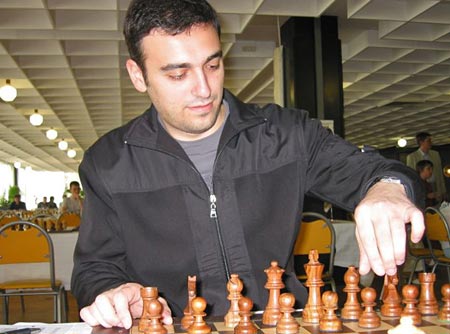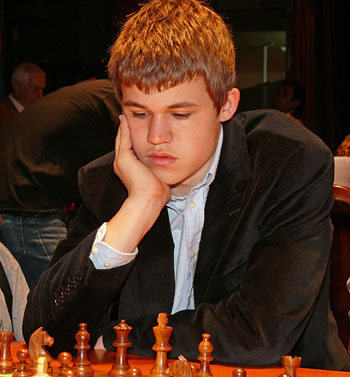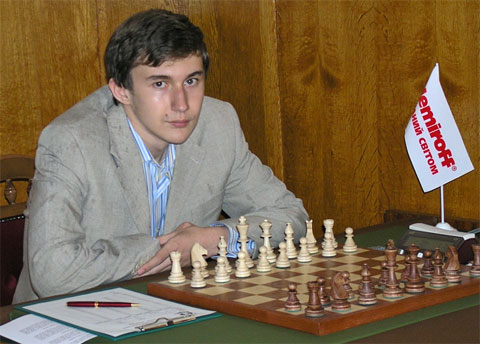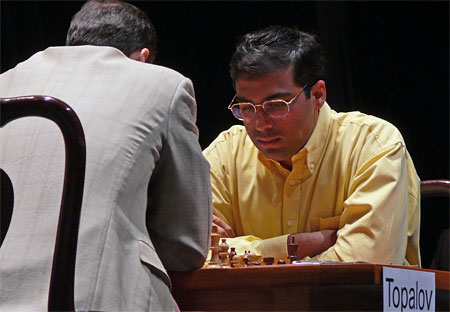| Latest | Greatest | Lobby | Journals | Search | Options | Help | Login |
|
|
|
This topic is archived. |
| Home » Discuss » Topic Forums » Sports |
|
| Jack Rabbit
|
Sun Jun-15-08 01:00 PM Original message |
| The Jack Rabbit Chess Report (June 15): Magnus magnificent in Foros |
|
Edited on Sun Jun-15-08 01:22 PM by Jack Rabbit
Magnus leads in Foros by 2 points
 Seventeen-year-old grandmaster Magnus Carlsen of Norway is dominating the field of the third annual Aerosvit International Tournament in Foros, Crimea (Ukraine) with 6 points after seven rounds. two points ahead of his nearest rival. There are only four rounds remaining in the eleven-round event. Were Magnus to draw all of his remaining games, one of three players currently tied for second place -- Sergey Karjakin, Andrei Volokitin and Pavel Eljanov, all from Ukraine -- would have to win three and draw one to surpass him on the table. Only Eljanov has played his game against Magnus, losing to Norwegian lad in the fourth round. Magnus will play Volokitin in round 10 and Karjakin in round 11. The tournament concludes Thursday. Reigning Armenian Champion Asrian Dies  Karen Asrian, the reigning Armenian national champion, died suddenly Monday morning at the age of 28 in the Armenian capital, Yerevan. The cause of death is a heart attack. Asian was stricken in his car while driving to the opening ceremononies of the Yerevan Giants rapid tournament. The annual tournament was renamed the Keren Asrian Memorial Tournament in his honor. Calendar Sparkassen Chess Meeting, Dortmund June 28-July 6. Competitors are former world champion Vladimir Kramnik, Shakhriyar Mamedyarov, Vassily Ivanchuk, Peter Leko, Loek van Wely, Ian Nepomniachtchi, Arkadij Naiditsch and Jan Gustafsson. World Open, Philadelphia June 30-July 6. Biel Chess Festival 19 July-1 August. This year's GM tournament features Magnus Carlsen, Evgeny Alekseev, Lenier Domínguez, Etienne Bacrot, Alex Onischuk and Yannick Pelletier. Politiken Cup, Copenhagen 19-27 July. Canadian Open, Montreal 19-28 July. Mainz Chess Festival 28 July-3 August FIDE Women's Knock Out (World Women's Chess Championship), Nalchik, Kabardino-Balkaria (Russia) 28 August-18 September. Anand-Kramnik World Championship Semifinal Match, Bonn October 14-November 2. Twelve rounds. Chess Olympiad, Dresden 12-25 November. |
| Printer Friendly | Permalink | | Top |
| Jack Rabbit
|
Sun Jun-15-08 01:03 PM Response to Original message |
| 1. This week's games |
|
Your humble hare acknowledges the assistance of Fritz 6.0 on analysis. Diagrams on the Jack Rabbit Chess Report are made with Chess Mérida, a true type font that can be downlaoded free here. !""""""""# $tMvWlVmT% $OoOoOoOo% $ + + + +% $+ + + + % $ + + + +% $+ + + + % $pPpPpPpP% $RnBqKbNr% /(((((((() WHITE White to move (This position is a theoretical draw) |
| Printer Friendly | Permalink | | Top |
| Jack Rabbit
|
Sun Jun-15-08 01:12 PM Response to Reply #1 |
| 2. Altounian - Kamsky, National Open, Las Vegas, Round 1 |
|
Edited on Sun Jun-15-08 01:13 PM by Jack Rabbit
 Gata Kamsky Levon Altounian - Gata Kamsky National Open, Round 4 Las Vegas, Nevada, 7 June 2008 German Exchange Game: Panov Opening (Caro-Kann Defense) 1.e4 c6 2.c4 d5 3.exd5 cxd5 4.d4 Nf6 5.Nc3 g6
6.Qb3 Bg7 7.Nge2 0-0 8.cxd5 Na6
9.g3 Qb6
10.Bg2
10...Rd8 11.0-0 Qxb3 12.axb3 Nb4 13.d6!?
13...exd6 14.Bf4
14...a6 15.Rfd1 Nc6
16.h3
16...h6 17.g4 Rb8 18.d5 Ne7
19.Ng3 b5 20.Nge4 Ne8 21.b4 g5 22.Be3 Bb7 23.f4 gxf4 24.Bxf4 Rbc8 25.g5
25...Ng6 26.Be3 h5
27.Bf3 Rc4!
28.Bxh5 Rxb4 29.Rab1?!
29...Rd7 30.Ng3?!
30...Re7
31.Bd2?
31...Bc8!
32.Re1 Bd4+ 33.Kh1
33...Be5 34.Nce4
!""""""""# $ +v+m+l+% $+ + To+ % $o+ O +m+% $+O+pV Pv% $ T +n+ +% $+ + + Np% $ P B + +% $+r+ R +k% /(((((((() WHITE: Levon Altounian Position after 34.Nc3e4 34...Rd4!
35.Bc3 Rxd5 36.Nf6+
36...Nxf6 37.gxf6 Rc7
38.Bxe5 Nxe5 39.Ne4
39...Bb7 40.Kh2 Rc2+ 41.Kg3
41...Rd3+ 42.Kf4 Bxe4
43.Kxe4
43...Rc4+ 44.Kf5 Rd5 45.Kg5
45...Nf3+ 46.Kh6 Rxh5+ 0-1
|
| Printer Friendly | Permalink | | Top |
| Jack Rabbit
|
Sun Jun-15-08 01:16 PM Response to Reply #1 |
| 3. Carlsen - Ivanchuk, IT, Foros, Round 1 |
 Magnus Carlsen Magnus Carlsen - Vassily Ivanchuk Aerosvit International Tournament, Round 1 Foros, Crimea (Ukraine), 8 June 2008 West India Game: King's Indian Defense (Aronin Variation) 1.d4 Nf6 2.c4 g6 3.Nc3 Bg7 4.e4 d6 5.Nf3 O-O 6.Be2 e5 7.O-O Nc6
8.d5
8...Ne7 9.b4
9...Nh5
10.Re1 f5 11.Ng5 Nf6 12.f3
12...Kh8
13.b5!?
13...Ne8
14.Be3
14...Bf6 15.Ne6 Bxe6 16.dxe6 Ng7?!
!""""""""# $t+ W T L% $OoO + Mo% $ + OpVo+% $+p+ Oo+ % $ +p+p+ +% $+ N Bp+ % $p+ +b+pP% $R +qR K % /(((((((() WHITE: Magnus Carlsen Position after 16...Ne8g7 17.Bh6!
17...Nxe6 18.Bxf8 Qxf8 19.c5?!
19...Nxc5 20.Bc4 Bg5
21.Qe2 Qh6
22.Rad1 Rf8 23.a4!?
23...b6 24.g3
24...Qh3 25.Qg2 Qh6 26.Qe2 Qh3
27.Kh1 Nd7
28.Ra1 Qh6 29.Ra2 Nf6
30.Kg2 Nh5!?
31.Nd5 Nxd5 32.Bxd5 Bf4?
!""""""""# $ + + T L% $O O + +o% $ O O +oW% $+p+ Oo+n% $p+ +pV +% $+ + +pP % $r+ +q+kP% $+ + R + % /(((((((() WHITE: Magnus Carlsen Position after 32...Bg5f4 33.Qf2!
33...fxe4
34.Bxe4 Qg5 35.Rc2 d5
36.Bxd5
36...Bxg3 37.hxg3 Nf4+ 38.Kf1 Nxd5 39.Rce2 Qf6
40.Rxe5 Qxf3 41.Qxf3 Rxf3+ 42.Ke2 Rf5 43.Rxf5
43...gxf5 44.Kd3 c5 45.Re5 Nb4+ 46.Kd2 1-0
|
| Printer Friendly | Permalink | | Top |
| Jack Rabbit
|
Sun Jun-15-08 01:18 PM Response to Reply #1 |
| 4. Karjakin - Jakovenko, IT, Foros, Round 4 |
 Sergey Karjakin Sergey Karjakin - Dmitry Jakovenko Aerosvit International Tournament, Round 4 Foros, Crimea (Ukraine), 11 June 2008 Epine Dorsal: Horseman Defense (Petroff Defense) 1.e4 e5 2.Nf3 Nf6
3.Nxe5 d6 4.Nf3 Nxe4 5.Nc3
5...Nxc3 6.dxc3 Be7 7.Bf4
7...0-0 8.Qd2 Nd7 9.0-0-0 Nc5 10.Be3
10...Re8 11.Bc4 Be6 12.Bxe6 Nxe6 13.h4 Qd7 14.Qd3 Qc6 15.Qf5 Qc4
16.Kb1 g6 17.Qh3
17...h5 18.Nd2
18...Qe2
19.Rde1 Qg4 20.Qh2 d5 21.f3 Qa4
22.g4
22...Bd6 23.Qg1!?
23...Ng7 24.Nb3
24...Qd7!?
25.Rd1 hxg4
26.fxg4 Re4 27.Rd4!
27...Rae8 28.Bc1
28...Be5?!
!""""""""# $ + +t+l+% $OoOw+oM % $ + + +o+% $+ +oV + % $ + Rt+pP% $+nP + + % $pPp+ + +% $+kB + Qr% /(((((((() WHITE: Sergey Karjakin Position after 28...Bd6e5 29.Rxe4!
29...dxe4 30.h5 gxh5?
31.gxh5!
31...Kh8 32.Qg5
32...f6 33.Qh6+ Kg8 !""""""""# $ + +t+l+% $OoOw+ M % $ + + O Q% $+ + V +p% $ + +o+ +% $+nP + + % $pPp+ + +% $+kB + +r% /(((((((() WHITE: Sergey Karjakin Position after 33...Kh8g8 34.Rg1!
34...Qf7 35.Nd4 f5
36.Bf4 Bxf4
37.Qxf4 Kh7
38.Rg6 Re7 39.Qh6+! 39...Kg8 40.Qg5 Kh7 !""""""""# $ + + + +% $OoO TwMl% $ + + +r+% $+ + +oQp% $ + No+ +% $+ P + + % $pPp+ + +% $+k+ + + % /(((((((() WHITE: Sergey Karjakin Position after 40...Kg8h7 41.Nxf5!! 41...Nxf5 42.Rf6 1-0 |
| Printer Friendly | Permalink | | Top |
| Jack Rabbit
|
Sun Jun-15-08 01:19 PM Response to Reply #1 |
| 5. Volokitin - Karjakin, IT, Foros, Round 5 |
 Andrei Volokitin Andrei Volokitin - Sergey Karjakin Aerosvit International Tournament, Round 5 Foros, Crimea (Ukraine), 12 June 2008 East India Game: Nimzo-Indeian Defense (Noa Variation) 1.d4 Nf6 2.c4 e6 3.Nc3 Bb4 4.Qc2 d5 5.a3 Bxc3+ 6.Qxc3 Ne4
7.Qc2 c5 8.dxc5 Nc6 9.e3
9...Qa5+ 10.Bd2 Nxd2
11.Qxd2 dxc4 12.Qxa5
12...Nxa5 13.Rc1
13...b5 14.cxb6 Bb7 15.bxa7
15...Ke7 16.Ne2 Rxa7 17.Nc3 Bc6 18.Na2 Rd7!?
19.Nb4
19...Ba4 20.Be2
20...Bb3 21.Bf3 f5 !""""""""# $ + + + T% $+ +tL Oo% $ + +o+ +% $M + +o+ % $ No+ + +% $Pv+ Pb+ % $ P + PpP% $+ R K +r% /(((((((() WHITE: Andrei Volokitin Position after 21...f7f5 22.e4!?
22...f4?!
23.g3
23...Rf8 24.gxf4 Rxf4 25.Ke2 Kd6
26.h4
26...Rdf7 27.Rh3 g6 28.Ke3 Nb7?
!""""""""# $ + + + +% $+m+ +t+o% $ + Lo+o+% $+ + + + % $ No+pT P% $Pv+ Kb+r% $ P + P +% $+ R + + % /(((((((() WHITE: Andrei Volokitin Position after 28...Na5b7 29.Bd1!
29...Rxf2
30.e5+ Kd7 31.Bf3 Rxb2 32.Bxb7
32...Rf5 33.Bc6+ Kc7 34.Be4 Rxe5 35.Nd3 Rc2
36.Nxe5 Rxc1 37.Rh1 Rc3+ 38.Kd4 Rg3 39.Rf1 c3 40.Rf7+ Kc8
41.Kc5 c2 42.Kd6 Bd5 43.Bxd5 exd5 44.Nc6 1-0
|
| Printer Friendly | Permalink | | Top |
| Jack Rabbit
|
Sun Jun-15-08 01:40 PM Response to Original message |
| 6. Bonus Game: Anand-Svidler, Mexico City, 2007 |
|
From the Tournament in Mexico City last Fall by winning which Vishy Anand become world champion.
 Vishy Anand Vishy Anand - Peter Svidler World Championship Tournament, Round 4 Mexico City, 18 September 2007 Spanish Grand Royal Game: Marshall Gambit 1.e4 e5 2.Nf3 Nc6 3.Bb5 a6 4.Ba4 Nf6 5.0-0 Be7 6.Re1 b5 7.Bb3 0-0 8.c3
8...d5 9.exd5 Nxd5 10.Nxe5 Nxe5 11.Rxe5 c6
12.Re1 Bd6 13.g3!?
13...Bf5 14.d4 Qd7 15.Be3 Rae8
16.Nd2
16...Bg4
17.Qc2
17...Bf5 18.Qc1 Re7 19.Nf3
19...Bg4 20.Nh4 Rfe8 21.Qd2 h6
22.Qd3 g6 23.Bd1 Bh3
24.Bf3 g5 25.Ng2 Bf5 26.Qd1 Nf6?!
27.a4
27...Ne4?
28.axb5!
28...axb5 29.Ra6 Qb7 30.Qa1 Bc8
31.Ra8 Bb8 32.Bc1 Nf6
!""""""""# $rVv+t+l+% $+w+ To+ % $ +o+ M O% $+O+ + O % $ + P + +% $+ P +bP % $ P + PnP% $Q B R K % /(((((((() WHITE: Vishy Anand Position after 32...Ne4f6 33.Rxe7!!
33...Rxe7 34.Qa3 Rd7
35.Ra5 Ba7
36.Ne3 Qc7
37.Nf5 c5
38.Nxh6+ Kh7 39.Bxg5 1-0
|
| Printer Friendly | Permalink | | Top |
| Jack Rabbit
|
Wed Jun-18-08 12:30 PM Response to Original message |
| 7. Update (Wednesday): Magnus wins the Aerosvit |
|
Magnus Carlsen, the 17-year-old grandmaster from Norway and the world's fifth ranked chess player, drew a hard fought game against Ukrainian GM Andrei Volokitin in 79 moves to win the third annual Aerosvit International Tournament in Foros, Crimea (Ukraine) with one round to spare.
Magnus has a point and a half lead over his nearest rivals, Ukrainian GMs Vassily Ivanchuk and Pavel Eljanov. Magnus will have Black in tomorrow's final round against Sergey Karjakin of Ukraine. In a game that will decide second place, Ivanchuk will have White against Eljanov. |
| Printer Friendly | Permalink | | Top |
| Jack Rabbit
|
Thu Jun-19-08 02:26 PM Response to Original message |
| 8. Update (Thursday): Foros Tournament Ends |
|
Unofficial Cross Table Aerosvit International Tournament Foros, Crimea (Ukraine) Participants. . . . . . .1 2 3 4 5 6 7 8 9 0 1 2 T. (W) .1 Magnus Carlsen. . . . .* 1 1 ½ 1 ½ ½ ½ 1 ½ 1 ½ 8. (5) .2 Vassily Ivanchuk. . . .0 * 1 ½ 1 ½ ½ 1 ½ ½ 1 ½ 7. (4) .3 Pavel Eljanov . . . . .0 0 * ½ 1 1 ½ ½ ½ ½ ½ 1 6. (3) .4 Sergey Karjakin . . . .½ ½ ½ * ½ 0 1 ½ 1 ½ ½ ½ 6. (2) .5 Alexei Shirov . . . . .0 0 0 ½ * ½ 1 ½ 0 1 1 1 5½ (4) .6 Andrei Volokitin. . . .½ ½ 0 1 0 * 0 1 ½ ½ 0 1 5½ (3) .7 Dmitry Jakovenko. . . .½ ½ ½ 0 0 1 * ½ ½ ½ 1 ½ 5½ (2) .8 Evgeny Alekseev . . . .½ 0 ½ ½ ½ 0 ½ * 1 1 0 ½ 5. (2) .9 Liviu-Dieter Nisipeanu 0 ½ ½ 0 1 ½ ½ 0 * ½ 1 ½ 5, (2) 10 Peter Svidler . . . . .½ ½ ½ ½ 0 ½ ½ 0 ½ * ½ 1 5. (1) 11 Loek van Wely . . . . .0 0 ½ ½ 0 1 0 1 0 ½ * ½ 4. (2) 12 Alex Onischuk . . . . .½ ½ 0 ½ 0 0 ½ ½ ½ 0 ½ * 3½ (0) |
| Printer Friendly | Permalink | | Top |
| DU
AdBot (1000+ posts) |
Fri Apr 26th 2024, 03:08 PM Response to Original message |
| Advertisements [?] |
| Top |
| Home » Discuss » Topic Forums » Sports |
|
Powered by DCForum+ Version 1.1 Copyright 1997-2002 DCScripts.com
Software has been extensively modified by the DU administrators
Important Notices: By participating on this discussion board, visitors agree to abide by the rules outlined on our Rules page. Messages posted on the Democratic Underground Discussion Forums are the opinions of the individuals who post them, and do not necessarily represent the opinions of Democratic Underground, LLC.
Home | Discussion Forums | Journals | Store | Donate
About DU | Contact Us | Privacy Policy
Got a message for Democratic Underground? Click here to send us a message.
© 2001 - 2011 Democratic Underground, LLC